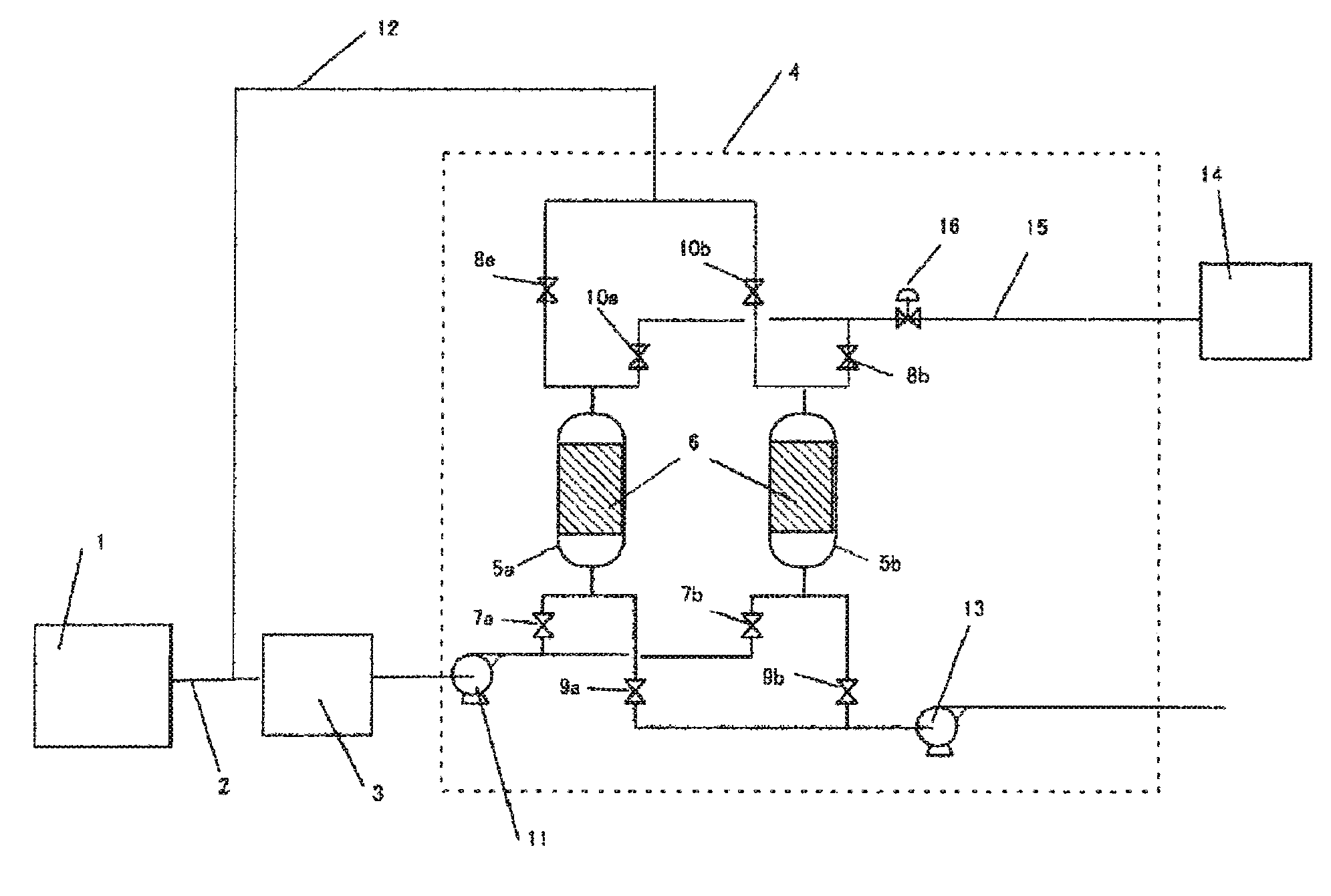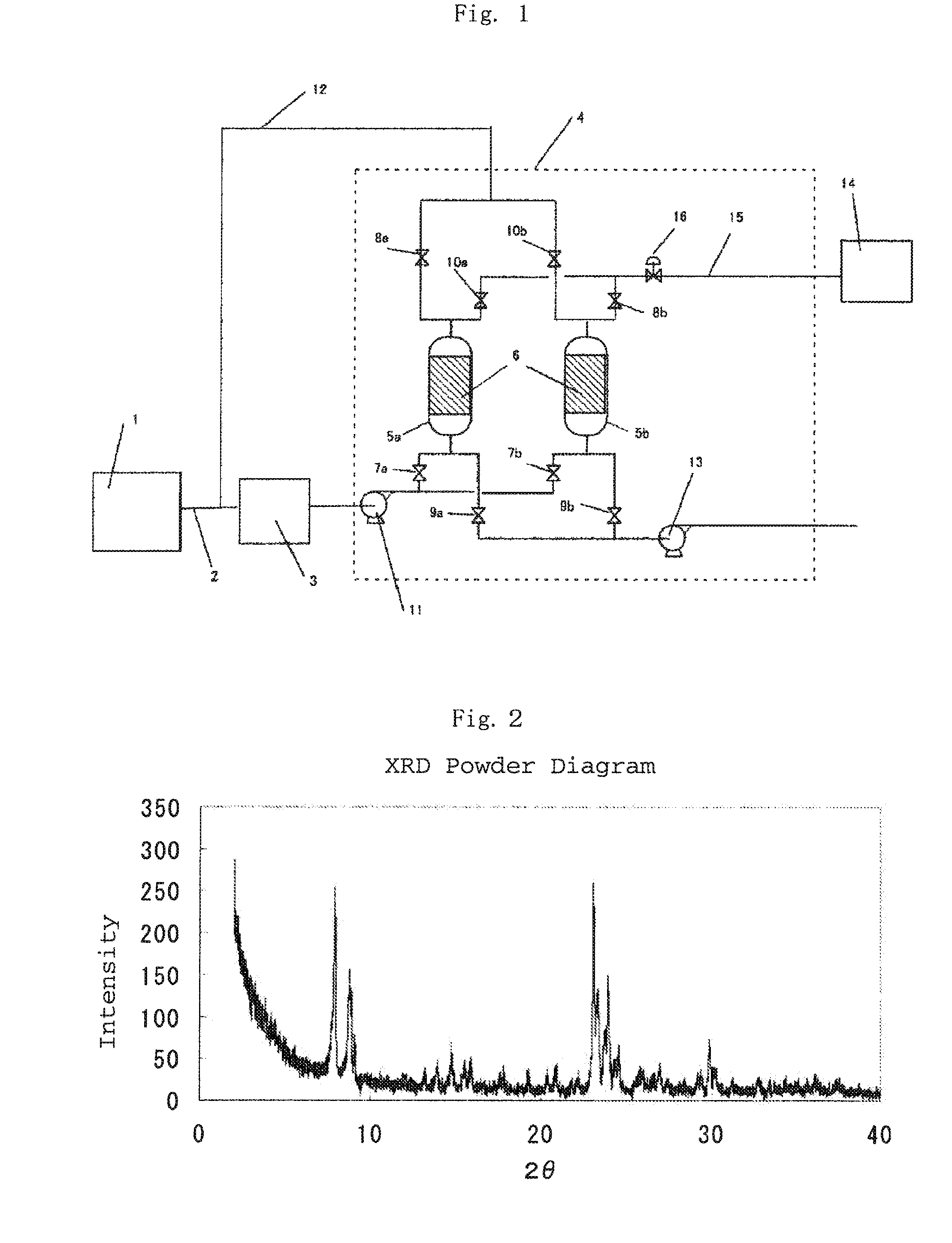Method and apparatus for producing and storing ozone using adsorbent
- Summary
- Abstract
- Description
- Claims
- Application Information
AI Technical Summary
Benefits of technology
Problems solved by technology
Method used
Image
Examples
production example 1
Pentasil-Type Zeolite (S-1)
[0085]5.93 g of aluminic acid was dissolved in 440 g of a 22.5 mass % of aqueous tetrapropylammonium hydroxide solution; this was added to 1.00 kg of tetraethyl orthosilicate; and hydrolysis of the tetraethyl orthosilicate was carried out by stirring for approximately 4 hours at 70° C. The obtained powder was placed in an 80° C. dryer and was held there for approximately 3 hours in order to completely finish the hydrolysis. This powder was saturated with water vapor at room temperature to obtain a dry gel containing a 9 to 15 mass % of water fraction, which was packed into a threaded plug-sealable bottle of polypropylene or Teflon (registered trademark). Hydrothermal synthesis was carried out by introduction of this bottle into an electric oven and holding for 72 hours at 140° C.
[0086]After the completion of the synthesis, the powder was removed from the sealed bottle and was re-introduced into an electric oven and the temperature was raised in an air atmo...
production example 2
Acid-Treated Pentasil-Type Zeolite (S-2)
[0089]Using the silicalite of Production Example 1 as the starting material, acid-treated pentasil-type zeolite exhibiting a strong Bronsted acid site strength was obtained by immersion of the silicalite in pH 1 hydrochloric acid solution, then filtration, drying for 1 hour at 110° C., then heating to 400° C. at a rate of temperature rise of 50° C. / hour and holding at 400° C. for 1 hour. Acid-treated pentasil-type zeolite containing up to about 20% noncrystalline material is also usable.
[0090]Using the silicalite of Production Example 1 as the starting material, acid-treated silicalite having an SiO2 / Al2O3 molar ratio of 20, 50, 200, 1,000, or 3,000 was obtained.
production example 3
Mesoporous Silica (S-3)
[0091]30 to 33 L of an aqueous solution of tetramethylammonium hydroxide (TMAOH, (CH3)4N, OH, FW 91.15, from Aldrich (25 weight % in water)) was added to 32 L water in which 6.0 kg cetyltrimethylammonium bromide (CTMAB, C16H35(CH3)3NBr, FW 364.45, produced by Tokyo Chemical Industry Co., Ltd.) was dissolved and the pH was adjusted to 7.7.
[0092]While vigorously stirring the mixture, 3.00 kg of sodium silicate (Na2O. 2SiO2.2.52H2O, FW 227.56, produced by Kishida Chemical Co., Ltd.) dissolved in 15.4 L of water was added, and the resulting suspension was stirred for 3 hours at room temperature. This suspension had the following gel composition: SiO2:CTMAB:H2O=0.8:0.5:190.
[0093]The precipitated product was filtered to separate a porous powder. After washing with water, this was placed in an electric oven and the surface moisture fraction was first removed by holding it for approximately 8 hours at 110° C. and the cetyltrimethylammonium bromide was then removed by ...
PUM
| Property | Measurement | Unit |
|---|---|---|
| Temperature | aaaaa | aaaaa |
| Dew point | aaaaa | aaaaa |
| Temperature | aaaaa | aaaaa |
Abstract
Description
Claims
Application Information
 Login to View More
Login to View More - R&D
- Intellectual Property
- Life Sciences
- Materials
- Tech Scout
- Unparalleled Data Quality
- Higher Quality Content
- 60% Fewer Hallucinations
Browse by: Latest US Patents, China's latest patents, Technical Efficacy Thesaurus, Application Domain, Technology Topic, Popular Technical Reports.
© 2025 PatSnap. All rights reserved.Legal|Privacy policy|Modern Slavery Act Transparency Statement|Sitemap|About US| Contact US: help@patsnap.com


